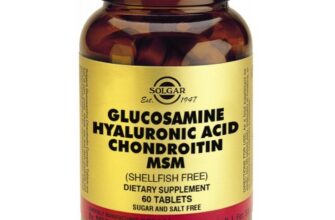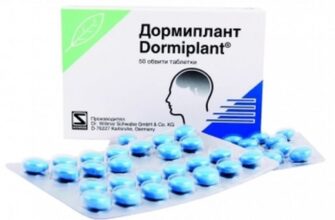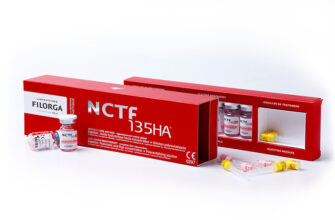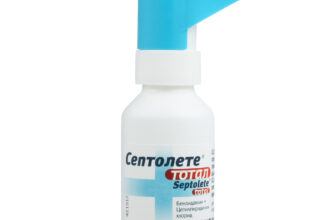Review of the best according to the editorial board. On the selection criteria. This material is subjective and does not constitute advertising and does not serve as a purchase guide. Before buying, you need to consult with a specialist.
Today our story is about arthrosis. Perhaps you cannot find a single elderly person, or even a middle-aged person, who does not have periodic joint pain. In this case, the pain is not accompanied by signs of inflammation. What does it mean? Signs of inflammation are: redness of the skin over the joint, its swelling or swelling, the presence of intense or mild pain, skin hot to the touch and impairment of its function, which is expressed in restriction of movement.
With arthrosis, pain also occurs, but it no longer has these inflammatory signs, but is accompanied by a crunch, arises at the beginning of the movement, and then, as motor activity continues, the joint is gradually 'worked in', and the pain disappears. Therefore, in the event that you have difficulty getting out of bed in the morning due to pain in your knees, groaning, and then, after half an hour, you understand that the pain has disappeared and the comfort of movement has returned, then you, no doubt, have arthrosis of the knee joints. How many people in our country suffer from this disease?
The statistics, however crude, are disappointing. There are more than 10 million patients in our country who have been diagnosed with arthrosis (that is, those patients who have actually undergone all the necessary types of examinations) and are being observed by a doctor, and these are only patients. That is, these are the people who have this diagnosis, and who periodically go to the doctor with certain complaints, medical records are kept. It is quite possible to double or triple this number if we add here those patients who have recurrent pain in certain joints, but who have never been examined and did not seek medical help.
However, at present, the number of patients with newly diagnosed arthrosis is only increasing, and, according to official data, from 2001 to 2005, the incidence of arthrosis increased by almost 50%.
The reason for this is the sedentary, office work of the urban population, and high physical activity in the rural population, if the condition is a wider coverage of medical services in the countryside, with a normal level of diagnosis. At the same time, it is disappointing that the incidence of arthrosis is growing at a relatively young age, starting from 45 years. If we take international statistics, then, according to WHO estimates, one of the main causes of disability is arthrosis of the knee joints, and it is in fourth place among all causes in women, and in men – in eighth place in general age categories. Before starting a review of drugs for the treatment of various forms of arthrosis, let us recall what kind of pathological condition it is, and what kind of arthrosis happens.
- Definition
- Symptoms and signs of arthrosis
- What is the difference between arthritis and arthrosis?
- A little about degrees, or stages
- Basic principles of arthrosis treatment
- Medicines for arthrosis
- NSAIDs
- Etoricoxib (Arkoksia, Costarox, Etoriax)
- Advantages and disadvantages
- Diclofenac (Voltaren, Ortofen, Diclac, Diclogen, Diclogen, Diclonac, Naklofen)
- Advantages and disadvantages
- Ketoprofen (Ketonal, Artrozilen, Artrum, Flamax, Flexen)
- Advantages and disadvantages
- Meloxicam (Movalis, Amelotex, Artrozan, Genitron, Mirlox, Movasin, Revmart),
- Advantages and disadvantages
- Local hormones for intra-articular administration
- Betamethasone (Diprospan, Betaspan, Flosterone)
- Advantages and disadvantages
- Artificial lubrication and chondroprotectors
- Synvisc
- Advantages and disadvantages
Definition
As we remember, the ending '-oz' does not mean an inflammatory process, but an overgrowth, an abundance of any tissue. This is the deformation and growth (compensatory) of the bone tissue on which the articular cartilage lies, due to its malnutrition, or dystrophy, and subsequent destruction, or degeneration.
Now the official term becomes clear, which is called 'dystrophic-degenerative pathology of articular cartilage'. A disease such as arthrosis, regardless of the joints in which these changes are observed, have many synonyms. If you hear the names of such diseases as: osteoarthritis, deforming arthrosis, deforming osteoarthritis, then they are all the same.
Of course, arthrosis is often combined with secondary inflammation, that is, with symptoms of arthritis. In this case, they speak of arthrosis-arthritis, or osteoarthritis. In any case, all this is one and the same condition associated with the destruction and malnutrition of the cartilaginous tissue, changes in the structure of the bones at the base of the joints. Only in one case, the process proceeds with the presence of an inflammatory component, and in the other case, without the presence of inflammation. Usually arthrosis without inflammation covers the entire joint completely, since ultimately not only the cartilage itself suffers, but also the synovium, the bone located under the cartilage, or the subchondral bone.
Further, the articular bag is involved in the process, and in advanced cases, we are already talking about the defeat of the periarticular muscles, or periarticular muscles. It goes without saying that ligaments located in the joint cavity, for example, the cruciate ligaments of the knee joint, are also involved in the inflammatory process. How does arthrosis manifest?
Symptoms and signs of arthrosis
As mentioned above, arthrosis most often occurs in the knee joints, and there are special reasons for this. It would seem, according to the logic of things, those joints that bear the greatest weight should be the most loaded, and in this case, these are the cartilages of the ankle joints, which bear almost the full weight of the human body. But these joints are arranged in such a way that the manifestation of arthrosis is just rare in them, but the knee joints (gonarthrosis) suffer much more often. In second place is arthrosis of the hip joints (coxarthrosis), and then arthrosis of the big toe, ankle joint, and arthrosis of the small joints of the fingers. How can one suspect the symptoms of classic arthrosis in oneself? Here they are:
The first and main symptom is pain in the limbs, more precisely, in the corresponding joints. In this case, the pain occurs not at rest, but during movement, often the pain has a starting character, and then, as the movement continues, the pain disappears.
What is the reason for this disappearance of pain? Initial pain appears when initially, before the start of movement, the articular surfaces are uneven, bumpy, they are covered with so-called tissue detritus, which is a kind of 'talker' of destroyed cartilage of a very small size. Detritus at night, at rest, gradually settles from the synovial fluid to the surface of the cartilage, like sand to the bottom, stirred up by the passage of a large ship.
After movement begins, this detritus and irritates the articular surfaces and surrounding tissues, causing starting pains. After 15-20 minutes, it is pushed out from the surfaces to the periphery of the joint and the pain disappears.
The more arthrosis progresses, the more intense the pain syndrome becomes, and the second stage of arthrosis leads to the fact that the pain occurs even with a weak load, and the third stage is characterized by constant pain when the joint is not even loaded. In addition, night pains are also characteristic in some cases, due to the difficulty of outflow from the affected joint.
The second characteristic symptom is a crunch in the affected joint, which is dry and 'rough' in nature.
This crunch is heard at a distance, and it is clear that it indicates the destruction of the articular cartilage, and the more arthrosis progresses, the greater the intensity of this crunch;
The third symptom is a gradual decrease in the range of motion, or freedom, in the corresponding joint.
Naturally, this is a later symptom than the previous ones. It occurs due to secondary muscle spasm, which is already chronic. The second reason for inactivity is a decrease in the lumen of the joint space, due to a violation of cartilage synthesis, as well as due to changes in bone tissue, that is, the development of growths – bone thorns, or osteophytes. Many in this picture saw a description of the radiograph in osteochondrosis, when, for example, in the thoracic and cervical spine there is a decrease in the height of the intervertebral discs, the development of hook-shaped osteophytes at the edges of the vertebrae, and so on. This is not unusual, since osteochondrosis of the intervertebral discs, or osteochondrosis of the spine, is the same arthrosis, only localized in the small joints between the vertebrae.
finally, in advanced stages, due to the addition of the inflammatory component (due to constant friction by the destroyed cartilage of the surrounding tissues), the volume of synovial fluid also increases.
The joint changes its external shape, configuration, the so-called reactive synovitis occurs. The pressure of the synovial fluid from the inside leads to deformation of the joints, their swelling and constant, aching and bursting pain. This stage includes, for example, the so-called phenomenon of patella ballotation. If the patient has a pronounced accumulation of synovial fluid in the knee joint, then it contributes to the bulging of the patella outward. Outwardly, this is imperceptible against the background of the swollen joint, but if you press on the patella and push it inward, it will sink into the depths, and then will again be pushed outward by the pressure of synovial fluid. This floating movement is well felt under the fingers of the orthopedic traumatologist.
What is the difference between arthritis and arthrosis?
How to distinguish arthritis from arthrosis? Above, we have already described the classic signs of arthritis, which are not observed with 'pure' arthrosis. It should be added that all symptoms of arthritis are associated with one or another severity of inflammation. Here are the main differences:
- arthritis can occur at any age, for example, in children or adolescents, autoimmune juvenile arthritis can develop, and arthrosis begins somewhere in the age of 40;
- arthritis can affect almost any joints, and quite often rheumatologists are faced with such pathologies as polyarthritis. Arthrosis is not capable from the very beginning of such a combination and damage to small joints. It can be said that arthrosis 'stupidly' affects large joints with great stress;
- the classic sign of difference is the difference in pain. With arthrosis, we know that pain occurs during movement, is most severe when starting to move, when getting out of bed, and is of a starting character. But with arthritis, pain does not depend on movement, and is most often associated with the appearance of severe inflammatory edema. And this edema occurs most of all at night, when the joint is immobile. Arthrosis at night in the initial stages will never hurt;
- from the point of view of various research methods, for example, MRI, arthrosis is, first of all, the destruction of cartilage tissue, which is clearly visible on tomograms. Arthritis does not lead to the destruction of cartilage, and primarily manifests itself in the reaction of other tissues.
Finally, age should be considered. Osteoarthritis almost always occurs at the age of over 40, and manifests itself as gonarthrosis, or knee arthrosis, or coxarthrosis-arthrosis of the hip joint. It is coxarthrosis that most often leads to disability and the need for endoprosthetics.
A little about degrees, or stages
Articular pathology is so 'good' that a lot of research is not required to determine the stages, or degrees. So:
- the initial stage has practically no symptoms, sometimes mild pain occurs during movement and during exertion;
- at the second stage, the pain is already changing, its intensification occurs. Yes, the patient can tolerate it, but it is no longer fleeting, but quite tangible. It is at this stage that the first osteophytes appear, which are clearly visible on x-rays, dystrophy and degeneration of cartilage tissue are noticeable, the very crunch appears;
- the third stage is an already developed clinical picture. The joints support sites themselves are grossly deformed, this leads to a change in the axes of rotation and even to deformation of the limbs themselves.
The articular ligaments are reflexively shortened, the pain becomes constant, the amplitude of motion in the joints decreases, the size of the joint space is sharply reduced. At the end of this stage, the joint is almost completely destroyed, and ankylosis occurs, that is, a state of complete immobility. It is at this stage that conservative treatment is no longer possible, and endoprosthetics is necessary.
However, you should not think that you can start the process and not be treated for any length of time, because 'as a result, you can still put a new artificial joint.' This is a serious misconception. Yes, of course, the affected joint can be 'thrown away' and replaced. But it must be remembered that severe and advanced arthrosis changes the state of the surrounding ligaments, muscles, and they cannot be replaced or removed. Therefore, the more started the process, the more serious, difficult and longer the subsequent rehabilitation process, even with the installation of the most modern and expensive imported endoprostheses.
Basic principles of arthrosis treatment
It is clear that with advanced stages, the only type of treatment that preserves the quality of life, eliminates pain, and restores freedom of movement is modern surgical intervention, that is, endoprosthetics. But the treatment of osteoarthritis begins already from the first stages, when non-drug therapy is of great importance. So, it is necessary:
- reduce the stress on damaged joints, for example, by reducing body weight;
- instead of long walks, you should use a bicycle or scooter;
- sometimes it is necessary to change working conditions. So, if a patient stands behind a conveyor for hours, and osteoarthritis of the knee joints progresses, then he needs to be transferred to other working conditions;
- the patient is assigned the correct orthopedic regimen;
- he goes in for swimming, conducts sessions of physiotherapy exercises;
- various physiotherapy procedures are prescribed;
- an important role is played by proper nutrition, aimed at improving the trophism of articular cartilage and improving the quality of connective tissue in general.
But between the second and third degrees of arthrosis, pain syndrome, as well as the frequent occurrence of associated inflammation, perhaps most severely worsen the quality of life in patients, and drug therapy is already needed here, including intra-articular blockades. Finally, we are smoothly moving on to a review of drugs that are used to treat arthrosis.
Medicines for arthrosis
Before listing the various drugs, it should be added that the list given in the article is not intended to make some of the manufacturers advertising or anti-advertising, their choice is justified by indications for use, clinical efficacy, publication of data in scientific journals. First of all, original drugs are presented and described, not generics. In the names of medicines, first, if any, the INN or international non-proprietary name common to the entire 'drug cluster' is given, then the first, original representative (the first created drug). Then there are examples of generics, or commercial copies of the original drug.
Further, the range of retail prices for pharmacies of all forms of ownership on the territory of the Russian Federation is given, prices are indicated from the original drug to the cheapest generic. And we will start our review of drugs with the most popular group, or with non-steroidal anti-inflammatory drugs.
| Nomination | a place | Name of product | price |
| NSAIDs | 1 | Etoricoxib (Arkoksia, Costarox, Etoriax) | 521 RUB |
| 2 | Diclofenac (Voltaren, Ortofen, Diclac, Diclogen, Diclogen, Diclonac, Naklofen) | 189 r | |
| 3 | Ketoprofen (Ketonal, Artrozilen, Artrum, Flamax, Flexen) | 116 RUB | |
| 4 | Meloxicam (Movalis, Amelotex, Artrozan, Genitron, Mirlox, Movasin, Revmart), | RUB 61 | |
| Local hormones for intra-articular administration | 1 | Betamethasone (Diprospan, Betaspan, Flosterone) | 175 RUB |
| Artificial lubrication and chondroprotectors | 1 | Synvisc | RUB 19 600 |
NSAIDs
Let's say right away that drugs from this group in no way affect the articular cartilage. They are therefore called 'anti-inflammatory' because they reduce inflammation. This means that they are primarily indicated for patients who have an inflammatory component, that is, there is arthrosis-arthritis. But do not think that even if there are no signs of inflammation, then these drugs will be ineffective. After all, the pain that occurs in a variety of diseases is formed not only as a nervous response, but, as well as a reaction to the destructive effect of tissue detritus, which accumulates in the joints, to secondary damage to muscles and ligaments.
And nonsteroidal anti-inflammatory drugs fight not only inflammation, but can also relieve fever in case of fever, and have a pronounced analgesic effect. There is a general law: you need to prescribe the drug in short courses, and in the presence of pathology of the stomach and duodenum, with gastritis, gastric ulcer, heartburn, cover up with drugs, proton pump inhibitors, which had a whole article, most often it is a simple drug omeprazole.
We list the most famous, effective, modern, and frequently used remedies for dystrophic-degenerative joint pathology from this group. Unfortunately, all of the above praises are not synonyms for any one group. It's impossible. So, the 'ancient' and rather crude remedy – diclofenac (Voltaren, Ortofen) is very effective, but it can be used in very short courses in case of exacerbation, no longer than 3 days. Arcoxia, or etoricoxib, can be considered a modern and safer drug. Ketoprofen, meloxicam can be considered frequently used agents. Let's get to know these representatives closer.
Etoricoxib (Arkoksia, Costarox, Etoriax)
Rating: 4.9
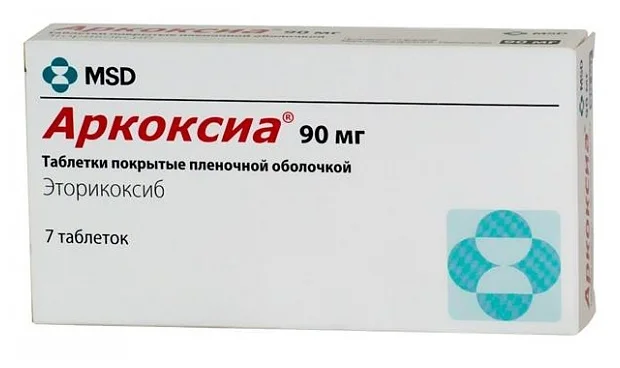
Arcoxia copes with pain and inflammation, but breaking the inflammation mechanism and easing symptoms does not mean eliminating the cause of the inflammation. Therefore, this drug should be prescribed best of all in short courses, in the first days after the onset of acute pain in the joint.
Arcoxia is not only a selective type 2 cyclooxygenase inhibitor, but it also exhibits a high degree of selectivity. Almost 95% is a connection with the desired isoform of the enzyme – COX 2. That is why this drug is safe and can be used even in patients with compromised gastric and duodenal mucosa, that is, in patients with various forms of gastritis and even gastric ulcer. however, during the period of remission and with the cover of certain drugs (Omeprazole). Etoricoxib, or Arcoxia, is capable of inhibiting cyclooxygenase in a dose-dependent manner. However, it has no effect on the first type of enzyme, which is influenced by very 'ancient' drugs, such as Diclofenac. The product is produced by the German company Merck, and the cost of 7 tablets of 0.09 g each is in January 2020 from 345 rubles. Costarox (India) will cost from 267 rubles, and Etoriax from Slovenia (KRKA) will cost about the same.
Advantages and disadvantages
Contraindication to use is a universal combination of bronchial asthma, sinus polyposis and aspirin intolerance. It is also the presence of ulcerative bleeding, when either, or an active state of erosive gastritis or gastric and duodenal ulcers. In general, these are all exacerbations of inflammatory bowel diseases such as Crohn's disease or ulcerative colitis. Arcoxia should not be used with low blood clotting, as well as with severe renal and hepatic insufficiency. The drug Arkoksia is contraindicated during pregnancy and during breastfeeding, as well as for children and adolescents, boys and girls under the age of 16. The drug can be used, but carefully if there is a history of ulcers, Helicobacter pylori infection, in persons with diabetes mellitus and chronic alcoholism, as well as in persons taking anticoagulants, such as Warfarin, or antiplatelet agents, such as Curantil, clopidogrel or acetylsalicylic acid.
Of the advantages, a high range of safety can be noted, and a low risk of complications.
Diclofenac (Voltaren, Ortofen, Diclac, Diclogen, Diclogen, Diclonac, Naklofen)
Rating: 4.8

Diclofenac, which is produced in ampouled form by the Serbian company Hemofarm, is very cheap: 47 rubles for 5 ampoules. Why ampoules? Because they act faster and more effectively than pills. By the way, the Russian company Biochemist also produces exactly the same ampoules, 3 ml each, but the package contains 10 ampoules, and at the same price. It is up to you to decide which packaging to purchase according to the doctor's prescription – a small Serbian one, or a large domestic one, but a small one is better. Voltaren, produced by the Lek company from Slovenia, is very high quality, but then a package of 5 ampoules will cost from 226 rubles. This drug is almost 5 times more expensive than Serbian, but it is an original remedy.
Diclofenac is an honorary 'grandfather' in the family of non-steroidal anti-inflammatory drugs, and despite its rather low safety spectrum, it is still loved and used. It is necessary to prescribe Diclofenac for a variety of diseases of the musculoskeletal system, for arthritis, for ankylosing spondylitis, in dentistry and orthopedics, it also finds application. Gynecologists prescribe it for algodismenorrhea, that is, for painful periods. But most of all it is used by neurologists, traumatologists and orthopedists. Many variants of arthrosis, acute back pain, neuralgia and radiculitis, exacerbation of protrusion of intervertebral hernias – this is not a complete list of indications for the use of Diclofenac.
It is very important to remember that a single dose is 1 ampoule. The agent must be injected deeply intramuscularly; the administration of the drug can be repeated no earlier than 12 hours later. Diclofenac injections can be treated for no longer than 2 days. In other words, purchasing a package of 5 ampoules is the best solution when it comes to sudden and short pain syndrome.
Advantages and disadvantages
If Diclofenac had no drawbacks, then it would have cost much more, since it very effectively relieves inflammation and fights pain, but it is not in vain that the drug is limited to two days. It is capable of causing gastritis, inflammatory bowel changes, pancreatitis and liver necrosis, fulminant, that is, fulminant form of toxic drug hepatitis. It is very dangerous to use Diclofenac for ulcers, patients with various forms of gastritis, and especially erosive and ulcerative. Therefore, if necessary, they are 'covered' with omeprazole tablets.
Headache, dizziness, skin rashes, and other side effects are common. In addition, the official instructions contain an impressive list of contraindications that must be taken into account by the doctor, and especially when it comes to elderly patients. But with all this, short courses of Diclofenac are able to put a person on their feet even with an acute pain syndrome, and its cheapness and good quality of the imported drug makes it a competitor to even stronger drugs.
Ketoprofen (Ketonal, Artrozilen, Artrum, Flamax, Flexen)
Rating: 4.8
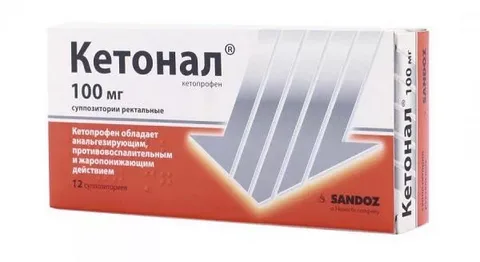
Ketonal is a more modern drug than Diclofenac, the next generation of drugs. Its active ingredient is ketoprofen, and each 2 ml ampoule contains 100 mg of it. It is indicated for use with severe pain syndrome of various origins, while of course, first of all, it is a lesion of the musculoskeletal system. These are various arthrosis, gonarthrosis and coxarthrosis at the third stage, bursitis and tendinitis, osteochondrosis and gout, rheumatoid arthritis and ankylosing spondylitis, psoriatic arthritis. Also, this remedy is used for pain syndrome due to malignant neoplasms, for migraines, headaches and radiculitis.
Ketoprofen in ampoules should be used no more than two ampoules per day. It is desirable that the course of treatment with ketonal does not exceed 3-5 days, and it is advisable to use the medicine in the smallest dosages that bring an effect, for example, 1 ampoule daily in the evening for 3 days. Ketonal is produced by the Lek company from Slovenia, and a package of 10 ampoules costs 227 rubles on average.
Advantages and disadvantages
The big plus of Ketonal is the permission of the official instructions to use it during pregnancy, of course, with extreme caution, and as short a course as possible. It should not be used only in the third trimester, when labor may be impaired. Contraindications to the use of the drug are about exactly the same as in other cases. In addition to hypersensitivity, it is an allergy to NSAIDs, that is, a combination of aspirin asthma, nasal polyposis and aspirin intolerance. This is an exacerbation of peptic ulcer disease, low blood clotting, childhood, severe hepatic and renal failure. It is contraindicated with a high risk of various bleeding. But in the event that it is prescribed in the case of various arthrosis in a short course in the absence of contraindications, then it is just as capable of bringing significant relief to patients with pain syndrome of the most diverse genesis.
Meloxicam (Movalis, Amelotex, Artrozan, Genitron, Mirlox, Movasin, Revmart),
Rating: 4.7
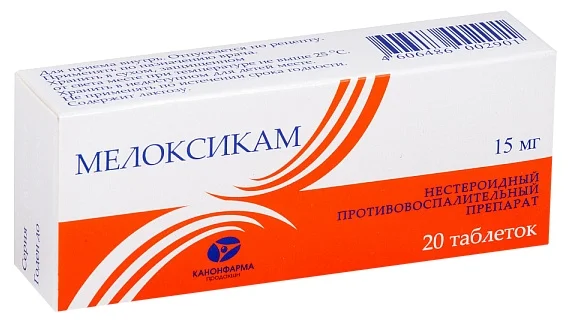
Movalis, or Meloxicam, is the last drug we have considered for deep intramuscular injections to relieve pain and inflammation, as well as relieve excruciating pain in advanced arthrosis and arthrosis arthritis. the first to be discovered from the group of oxicams – COX 2 inhibitors. Movalis is the original meloxicam drug produced by the German company Boehringer Ingelheim, and a pack of 3 ampoules will cost 850 rubles. Movalis belongs to the group of non-steroidal anti-inflammatory drugs that can reduce all the classic signs of inflammation: redness, fever, soreness and swelling. The action of the drug is based on the blockade of prostaglandin synthesis.
Shown is a remedy for diseases of the musculoskeletal system, various forms of arthritis, arthrosis and osteoarthritis. The classic indications for Movalis are acute pain in the lower back, lumbago, other forms of dorsopathy, shoulder periarthritis and other diseases. In the case of uncomplicated pain syndrome, for example, with osteoarthritis, one 1.5 ml ampoule containing 7.5 mg of Movalis is injected intramuscularly. In severe cases, two ampoules are administered per day, for example, in rheumatoid arthritis. You cannot enter more than two ampoules daily, that is, more than 15 mg.
Advantages and disadvantages
The drug is packaged in 3 ampoules: this is quite enough for three days of primary relief of acute pain syndrome. Contraindications and side effects in Movalis are typical for all NSAIDs, they have been repeatedly named above, and we will not dwell on them. Of course, the high cost of the drug is striking: one ampoule for administration costs 283 rubles, and one ampoule of diclofenac, even if you take an expensive imported package, will cost 8 rubles. We find that the cost of one day of treatment with diclofenac is 32 times cheaper than one injection of Movalis. This is exactly the situation that was described above. If diclofenac did not have so many side effects, it would be much more expensive. This is not expensive Movalis, this is Diclofenac too cheap. In general, the most accessible meloxicam in injections, or one of the most affordable, is 50 rubles for 3 ampoules of domestic production.
Local hormones for intra-articular administration
Local hormonal drugs, which are long-acting corticosteroids, are a real panacea for patients with prolonged, persistent pain, at the third stage of advanced arthrosis with the addition of arthritis symptoms, with the presence of synovial effusion and an increase in the volume of synovial fluid. Moreover, you cannot take hormones inside, with arthrosis, and arthrosis-arthritis, intra-articular administration is necessary, using a syringe with a needle in a medical institution.
If the agent is injected into the joint cavity, then it acts quickly, without side effects, or with minimal manifestation, since it does not enter the bloodstream, and the drug can have a very long-term effect. The most famous drugs used in arthrology for the treatment of chronic pain syndrome and relief of inflammation in arthrosis are Diprospan and Kenalog.
As a result, steroid hormones, for a long time (up to six months after one injection!), Allow the patient to improve the range of motion, increase the mobility in the joint, reduce pain, and relieve inflammation.
But at the same time, despite the elimination of unpleasant symptoms, they do not lead to the restoration of articular cartilage. Consider an example of local hormone therapy using betamethasone, using the example of such a drug as Diprospan. This will be quite enough, since only 2 corticosteroid hormones are used in medicine for intra-articular administration. The first of them is betamethasone, which will be described below, and the second is triamcinolone, which is produced under the guise of Kenalog. Since they are from the same group, they have a lot in common.
Betamethasone (Diprospan, Betaspan, Flosterone)
Rating: 4.9
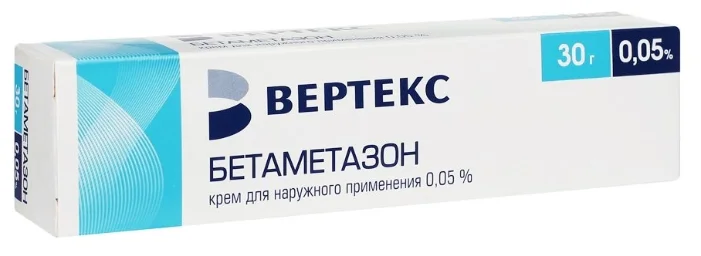
Diprospan is a quality suspension consisting of two betamethasone compounds. It has a transparent, yellowish or colorless color, slightly viscous consistency, which contains whitish particles. The ampoule also contains additional substances. Each ampoule contains one milliliter of this suspension. The tool has a high anti-inflammatory, as well as antiallergic and immunosuppressive effect. We are interested in just the first effect, therefore, first of all, Diprospan is used for diseases of the musculoskeletal system, and of course, for various types of arthrosis, and especially with an inflammatory component.
A very important and valuable property of diprospan is considered to be a very slow release of it from the depot, in this case from the joints. For various types of arthrosis, Diprospan is used not only intraarticularly, but also periarticularly, and it must be remembered that it cannot be used intravenously or subcutaneously. If local administration is necessary, it is usually possible not to use a local anesthetic, and usually one to 2 ml per joint is sufficient for injection into large joints.
The duration of the clinical effect after one injection can last up to a month or longer, with a very good response – up to six months. You can buy one ampoule of Diprospan in pharmacies at a price of 260 rubles, respectively, the same amount will cost one injection, and for a large one, for example, for a knee joint, it can be 2 milliliters. If we assume that there can be severe gonarthrosis with pain on both the right and left, then the maximum dosage for all two knee joints will be 4 ml, that is, about 1000 rubles. drug consumption.
Advantages and disadvantages
The main advantage of intra-articular hormones is the low likelihood of developing a systemic effect, for example, an increase in blood pressure, a decrease in potassium in the blood plasma, or 'classic' – erosive and ulcerative lesions of the gastrointestinal tract, a decrease in the rate of wound healing, and so on. Such side effects usually occur with systemic administration of corticosteroid drugs. The second advantage is a fairly long-term effect, but nevertheless it is necessary to remember the main contraindications to the appointment of corticosteroid hormones, even for intra-articular administration. First of all, these are systemic mycoses, that is, a fungal infection with damage to the internal organs and penetration into the blood, the presence of an acute joint infection, for example, brucellosis, or tuberculous arthritis, the presence of hypersensitivity to betamethasone. It is better to refrain from using hormones, even intra-articularly, for pregnant women.
Artificial lubrication and chondroprotectors
Artificial lubrication, or synovial fluid, always needs high quality. It has many functions: nourishes cartilage, reduces friction in the joint, absorbs shocks and acts as a shock absorber. Natural lubricant is a permanently renewable, viscoelastic polymer. It is always on the surface of the cartilage, lubricates them and also nourishes them. Patients should remember that since 2003, the World Health Organization has been recommending the use of artificial lubricants in the complex therapy of arthrosis, when conservative treatment becomes ineffective.
If there are joint prostheses, that is, endoprostheses, then artificial lubrication can also be called a synovial or joint fluid prosthesis. The main indication for its use is pain, discomfort during movement, as well as stiffness in the joints. When there is little natural lubrication, then an artificial drug is used, and it, like hormones, is injected intra-articularly, and strictly into the synovial gap.
There are many proven effects of artificial synovial fluid. If you undergo a course of injections, then the patient returns to light and painless movements for several months, and even up to a year. Usually, during each course, 5 injections are given at regular intervals, and the duration of the effect depends on the quality and on the choice of the drug.
Of course, the maximum effect is brought by the timely introduction of a joint fluid substitute, and these are the initial stages of arthrosis. If there are already major changes, then any remedy will be less effective, since the cartilage will already be destroyed. After all, even high-quality lubrication of seriously damaged gears in any engine will not fix the problems: it will hum and collapse further.
What are the general contraindications against the introduction of artificial synovial fluid? It:
any local inflammation in the joint, since against the background of the inflammatory focus, any artificial joint fluid is destroyed, which consists of hyaluronic acid, and natural too;
a synovial fluid prosthesis is not used in autoimmune pathology, for example, in rheumatoid arthritis, but this is not the purpose of our article;
An allergic reaction to natural synovial fluid, which is of animal origin, can become a rather unpleasant fact, and this reaction can be up to anaphylactic shock, therefore it is best to prescribe synthetic synovial fluid prostheses, although they are more expensive.
The better the drug, the less often the patient will have to undergo repeated treatment, and the longer the drug will last. What determines the effect of the drug? From the size of the drug molecules. It is preferable to use high molecular weight drugs, since they are more slowly excreted from the body and are slowly destroyed, providing the so-called prolonged action. If the molecular weight of the agent is small, then the hyaluronic acid molecule quickly breaks down into fragments, separates, and is removed from the joint.
Recall that the natural, natural joint fluid, which is the standard, has a mass of about 3 million daltons. Low molecular weight drugs are up to 800,000, and high molecular weight artificial joint fluid is more than 2.5 million units. As one of the reference drugs that make up artificial joint lubrication, here we will present the American drug Synvisc.
As for chondroprotectors, they have been repeatedly written about in other articles. These are simple nutritional supplements that do not have an evidence base, since both glucosamine and chondroitin sulfate from the blood do not penetrate into the joints, but are distributed as desired by the body, breaking down into smaller fragments. Therefore, it is much cheaper to just eat jellied meat than to buy an expensive and useless product.
Synvisc
Rating: 4.9
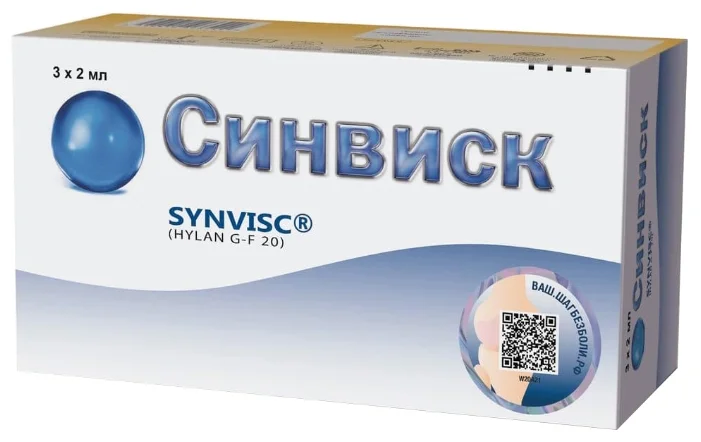
It is available in a pack of 3 ampoules, 2 ml each, costing 24,500 rubles. Accordingly, the price of 1 ml will be just over 4000 rubles. Such a high price is quite justified, the message of Synvisc is a highly viscous, elastic liquid, with an average molecular weight of about 6 million daltons, that is, 2 times thicker and heavier than natural lubricant. It is composed of gilans, not hyaluronic acid, hilans are hyaluronic acid derivatives that are composed of repeating disacchars. These are acetylglucosamine and sodium hyaluronate. Naturally, it must be injected strictly into the joint cavity if there is not a large amount of effusion.
In the case of osteoarthritis of the knee joint, 3 injections are needed every one week, as a course of treatment. With this dosing regimen, the usual effect of use lasted for 26 weeks, and in the case of osteoarthritis of the knee joint, the best response times were 52 weeks, after 1 course of three injections. Therefore, the high cost of this tool is explained by the quality, but it should be remembered that it is considered expensive in our country, since it is necessary to pay about the average monthly salary for it. In the United States, a skilled worker receives about $ 25 per hour of work, while in Russia this figure is just over $ 3, so in the country of manufacture this tool is eight times cheaper.
Advantages and disadvantages
Synvisc contains a tiny bit of chicken protein. Therefore, if the patient has an intolerance, or hypersensitivity, then you need to be careful. The insertion procedure is usually well tolerated, and occasionally there may be short-term pain or swelling, but this is rare. Some disadvantage is the way of application. First, intra-articular injection is required, removal of a certain amount of synovial fluid, in a volume equal to the injected volume, warming the drug to room temperature, adherence to strict aseptic rules, selection of the size and length of the needle depending on the joint. Therefore, healthcare providers need to learn how to administer this drug. However, such rules are needed for the introduction of absolutely all synovial fluid prostheses, without exception, and the difference is only in packaging, volumes, prices and quality. In many cases, the drug is administered under X-ray control.
The popularity rating is based on the analysis of demand data from the wordstat.yandex.ru service.
Attention! This rating is subjective and does not constitute an advertisement and does not serve as a purchase guide. Before buying, you need to consult with a specialist.

